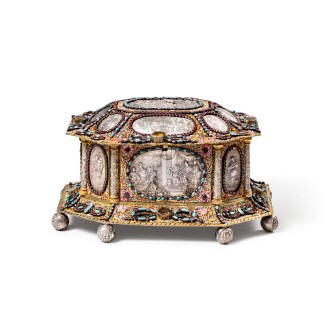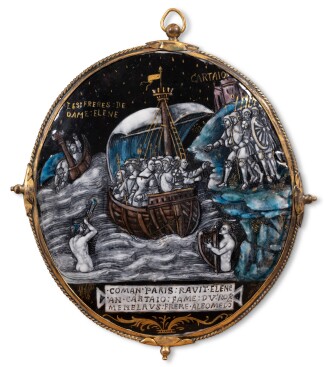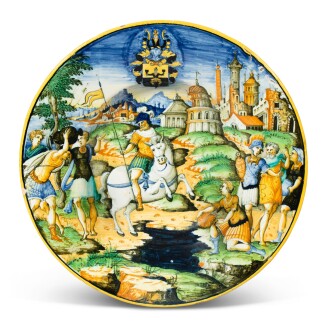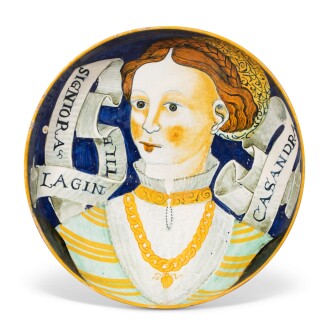V olume II, Kunstkammer is dedicated to the princely spirit of aristocracy and the patrons of the Renaissance, with an exquisite selection of rock crystal, enamels and impressive German silver-gilt objects. Displayed at the Hôtel Lambert in the Salon des Emaux and in the Salon des Curiosités, these sumptuous objects are a reflection of the tradition of the Kunstkammer, where certain materials and precious objects were associated with a philosophical reflection on Humanity and the Earth. Limoges painted enamel dishes and plaques made by the most famous artists of the 16th and 17th centuries – including Colin Nouailher, Leonard Limousin and Pierre Reymond and their workshops – will be presented alongside finely crafted silver-gilt tankards, covered cups, nefs, ostrich eggs and vessels, and a number of unexpected, unique objects such as a fantastic Flemish owl from the mid-17th century. At the heart of the collection is a group of silver-gilt mounted rock crystal vases and tazzas, which pay tribute to the renowned collection assembled by Cardinal Mazarin and King Louis XIV, now held at the musée du Louvre and in the Prado.
Proceeds from the sale to support The Al Thani Collection Foundation.
Auction Highlights

Enamels

Ceramics & Maiolica

Silver

The Greatest Collector of His Generation
by Alexis and Nicolas Kugel

From 11–14 October, the incredible collections of the Hôtel Lambert will be brought to auction. Within a short decade, Sheikh Hamad bin Abdullah Al Thani and his immediate family managed to bring the original grandeur back to Hôtel Lambert, located on the tip of Île Saint-Louis in Paris, and with the assistance of the decorator Alberto Pinto, this extraordinary masterpiece of 17th-century French architecture was adorned with treasures of French art and a great number of 18th-century Renaissance objects.

“The first time that I met Sheik Hamad,” remembers Nicolas Kugel, “was about fifteen years ago. He was elegant and friendly, with a perfect mastery of the French language. He recognised a magnificent vase from the Karl Lagerfeld collection at the gallery, and he immediately purchased it. That was the beginning of a long relationship based on trust. The connoisseur continually enriched his knowledge of furniture and antique art objects, visited museums and exhibitions, and frequented art historians, curators and antiques dealers. With a combination of curiosity and an exceptional visual memory, he is most certainly the greatest collector of his generation (OR – he assembled what is most certainly the greatest collection of its type in a generation).” The effusive words of the two Parisian antiques dealers, Alexis and Nicolas Kugel, show the excellent standards established for the collections which were amassed over a decade for the Hôtel Lambert.

Sheikh Hamad bin Abdullah Al Thani, today in his forties, has had a passion for the arts since childhood. He owes that to his mother, who first brought him to the Louvre and initiated him to the beauty of French castles. Bit by bit, he learned of 17th- and 18th-century refinements, the hallmarks of goldsmiths, the quality of European porcelain – from Meissen to Vincennes to Sèvres –, and the techniques of Japanese lacquer. His residences in Doha, London and Paris reflect his taste for beautiful objects, and for royal and princely provenances. In addition to his knowledge of objects, the prince has an understanding of the art market and its prices, making his own decisions, in swift succession and backed by substantial financial means. When his family purchased the legendary Hôtel Lambert in 2007, the challenge was considerable. How would it be possible to bring back the former splendour to this dilapidated residence? The task appeared impossible, if only in light of the names of its former owners. Indeed, in 1639, it was Jean-Baptiste Lambert who commissioned the construction and decoration of his mansion to the architect Louis II Le Vau and the painters Eustache Le Sueur and Charles Le Brun. Arranged around a U-shaped courtyard, the superb residence features several adjoining reception rooms and a Hercules Gallery, which heralded the Hall of Mirrors in Versailles. Hôtel Lambert went on to belong to the tax-farmer Claude Dupin, the Marquis of Le Chatelet, the Czartoryski family, the Chilean collector Arturo Lopez Willshaw – who invited his friend Alexis de Rédé to live there –, and Baron Guy de Rothschild and his wife Marie-Hélène, who called on the decorators Georges Geoffroy and Renzo Mongiardino. Baron Guy installed the Rothschild collections taken from Château de Ferrières into the comfortable living areas, and established a memorable cabinet of enamels of which the trompe l’œil features remain intact today. After the death of Baron Guy, his collections were scattered, including Vermeer’s famous The Astronomer, (donated to the Louvre). That was when Sheik Hamad Bin Abdullah Al Thani took the destiny of Hôtel Lambert into his own hands. He launched a colossal restoration project and asked Alberto Pinto to make it into a “family home”. Armchairs, sofas, tapestries and rugs were selected to coordinate with porcelain and gold objects to form coherent wholes. “At Hôtel Lambert,” explains Nicolas Kugel, “Sheik Hamad wanted to pay tribute to the Rothschild taste through that unique mixture of precious gold objects, rare furniture and original artwork.” The décor features mounted nautilus shells, Renaissance Limoges enamels, and silver hanaps. In the Hercules Gallery, which is now a dining room, fluted porphyry vases frame the windows overlooking the garden and Seine River. The old magic was brought back to Hôtel Lambert. Twelve years on, the building having been sold, Sotheby’s is bringing those collections to auction. A major part of the proceeds will benefit The Al Thani Collection Foundation which supports cultural and heritage projects around the world.

Among the approximately one thousand two hundred fifty lots to be offered for sale are pieces with prestigious provenances: Madame de Pompadour, Madame du Barry, Queen Marie-Antoinette, Count Stroganoff, Prince Anatole Demidoff, Richard Wallace, and Antenor Patino, the son of the Bolivian tin tycoon. In furniture, the department director of Sotheby’s – Louis-Xavier Joseph – highlights the importance of various pieces: the Bernard I Van Risenburg commode that belonged to Jean-Baptiste Machault d’Arnouville, armchairs by Nicolas Heurtaut, and the occasional table with a palm-shaped pedestal that the King of Prussia gave to the Russian Empress Maria Feodorovna and that remained for many years at Pavlovsk Palace. In artwork, he emphasises the Portrait of a bearded gentleman by Jan Sanders Van Hemessen (vers 1540), the Portrait of Pierre Vincent Bertin (1685) by Hyacinthe Rigaud, and The Union of Comedy and Music (1717) by Antoine Watteau. Among the many French and English gold objects, his top picks include a terrine dish by Jacques-Nicolas Roettiers (1770) that Catherine the Great gave to Count Orlov and a pair of Roman busts from the collection of Carlos de Beistegui at the Palazzo Labia of Venice. “When we visited Hôtel Lambert with Sheik Hamad,” concludes Alexis Kugel, “his enthusiasm was palpable. The dense, luxurious, original decoration in this sublime historical setting is a reminder that true collectors continue purchasing even when they run out of space! In a word, it is a treasure collection.” Worth noting are six baroque rock crystal chandeliers of Kugel provenance, two large 17th-century porphyry vases flanked by volutes and female masks, six-branch candelabra attributed to Pierre-Philippe Thomire, a pair of neoclassical lanterns, and two monumental vases thought to be designed by Charles Delafosse. Among the Chinese objects that were brought to France in the 18th century, some of the remarkable pieces include a Ming dynasty celadon vase with an incredible mount from the 1750s by Jean-Claude Duplessis and a pair of vases from the Kangxi period that is adorned with a Rocaille frieze and dragon-shaped handles and topped with a gilded fruit. A microscope attributed to Claude Simeon Passemant and sculpted by Jacques and Philippe Caffieri in a tribute to the union between the sciences and the arts appears to have come straight out of a cabinet of curiosities. Additionally, in keeping with the true Rothschild spirit, the exquisitely opulent array includes a hanap by Hans Hessel, a silver vessel by Esaisas zur Linden, a Limoges enamel dish by Pierre Reymond, the agate and lapis-lazuli “coupes Lebrun”, and the “coffret Rothschild” by Hans Jakob Mair decorated with enamel, semi-precious stones, and Lorenz I Biller’s silver relief.
Interview by Guy Boyer
Read Less

































